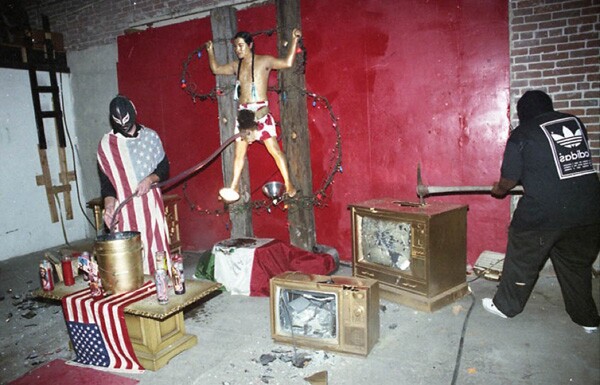Regeneración: Public Resource Center
Chicano youths in Los Angeles experienced displacement issues in the city's urban overgrowth embedded with social, political, and economic injustices. Some found a new identity and an outlet to voice their frustrations in punk rock music. Neither feeling American or Mexican, they felt the music spoke to the soul of the Chicano community, appealing to their dual cultural identities. There had been bands in the 1970s and 1980s that sparked rebellion within the Latino youth community, notably The Bratz, Los Illegals and the Plugz, but few survived the recording industry's marketing restrictions, limiting the Chicano punk scene to not much more than local clubs and house parties.
Socially conscious Latino-led bands like Ozomatli, Aztlan Underground, Blues Experiment, Ollin, and Slowrider boomed throughout the Northeast corridor in the 1990s. But one would galvanize contemporary cultural politics with art in Highland Park - Rage Against the Machine, led by vocalist Zack de la Rocha.





De la Rocha grew up between Lincoln Heights, his original home, and Irvine after his parents divorced. His grandfather, an agricultural laborer in the United States, was a Sinaloan revolutionary who fought in the Mexican Revolution of 1910. His father Roberto "Beto" de la Rocha was a member of the artist collective Los Four as an active Chicano artist/muralist in the 1970s. Zack de la Rocha founded the Public Resource Center/Centro de Regeneración in Highland Park in the 1990s. The name is derived from the anarchist journal that served as the voice of the Mexican Liberal Party in the early 1900s.
Regeneración encompassed a library of political literature, featuring artwork by local artist and co-founder Aida Salazar. With this space de la Rocha sought to inform and create an on-going mobilization of the working poor, avoiding the accumulated social frustration that limited political action during presidential elections. It was a space where art, community, and politics merged in Highland Park, just as art collectives had done a generation before, but with an invested interest in global politics.
In 1994 the Zapatistas, a revolutionary leftist group based in Chiapas, Mexico, declared war against the Mexican state and brought attention to their cause on the then-emerginng platform of the internet. De la Rocha, inspired and re-politicized, joined their efforts, using his celebrity to fundraise for the Zapatistas through Regeneración.











Post Movement
The Political Climate
Figueroa Street